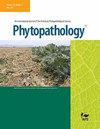求助PDF
{"title":"草酸在 Clarireedia jacksonii 对匍匐翦股颖的毒力和发育过程中的作用。","authors":"Daowen Huo, Nathaniel M Westrick, Ashley Nelson, Mehdi Kabbage, Paul Koch","doi":"10.1094/PHYTO-03-24-0094-R","DOIUrl":null,"url":null,"abstract":"<p><p>Dollar spot is a destructive foliar disease of amenity turfgrass caused by <i>Clarireedia</i> spp. fungi, mainly <i>C. jacksonii</i>, on the Northern United States region's cool-season grass. Oxalic acid (OA) is an important pathogenicity factor in related fungal plant pathogens such as <i>Sclerotinia sclerotiorum</i>; however, the role of OA in the pathogenic development of <i>C. jacksonii</i> remains unclear due to its recalcitrance to genetic manipulation. To overcome these challenges, a CRISPR/Cas9-mediated homologous recombination approach was developed. Using this novel approach, the oxaloacetate acetylhydrolase (<i>oah</i>) gene that is required for the biosynthesis of OA was deleted from a <i>C. jacksonii</i> wild-type (WT) strain. Two independent knockout mutants, Δ<i>Cjoah-1</i> and Δ<i>Cjoah-2</i>, were generated and inoculated on potted creeping bentgrass along with a WT isolate and a genome sequenced isolate LWC-10. After 12 days, bentgrass inoculated with the mutants Δ<i>Cjoah-1</i> and Δ<i>Cjoah-2</i> exhibited 59.41% lower dollar spot severity compared with the WT and LWC-10 isolates. OA production and environmental acidification were significantly reduced in both mutants when compared with the WT and LWC-10. Surprisingly, stromal formation was also severely undermined in the mutants in vitro, suggesting a critical developmental role of OA independent of plant infection. These results demonstrate that OA plays a significant role in <i>C. jacksonii</i> virulence and provide novel directions for future management of dollar spot. [Formula: see text] Copyright © 2024 The Author(s). This is an open access article distributed under the CC BY 4.0 International license.</p>","PeriodicalId":20410,"journal":{"name":"Phytopathology","volume":" ","pages":"2394-2400"},"PeriodicalIF":2.6000,"publicationDate":"2024-11-01","publicationTypes":"Journal Article","fieldsOfStudy":null,"isOpenAccess":false,"openAccessPdf":"","citationCount":"0","resultStr":"{\"title\":\"The Role of Oxalic Acid in <i>Clarireedia jacksonii</i> Virulence and Development on Creeping Bentgrass.\",\"authors\":\"Daowen Huo, Nathaniel M Westrick, Ashley Nelson, Mehdi Kabbage, Paul Koch\",\"doi\":\"10.1094/PHYTO-03-24-0094-R\",\"DOIUrl\":null,\"url\":null,\"abstract\":\"<p><p>Dollar spot is a destructive foliar disease of amenity turfgrass caused by <i>Clarireedia</i> spp. fungi, mainly <i>C. jacksonii</i>, on the Northern United States region's cool-season grass. Oxalic acid (OA) is an important pathogenicity factor in related fungal plant pathogens such as <i>Sclerotinia sclerotiorum</i>; however, the role of OA in the pathogenic development of <i>C. jacksonii</i> remains unclear due to its recalcitrance to genetic manipulation. To overcome these challenges, a CRISPR/Cas9-mediated homologous recombination approach was developed. Using this novel approach, the oxaloacetate acetylhydrolase (<i>oah</i>) gene that is required for the biosynthesis of OA was deleted from a <i>C. jacksonii</i> wild-type (WT) strain. Two independent knockout mutants, Δ<i>Cjoah-1</i> and Δ<i>Cjoah-2</i>, were generated and inoculated on potted creeping bentgrass along with a WT isolate and a genome sequenced isolate LWC-10. After 12 days, bentgrass inoculated with the mutants Δ<i>Cjoah-1</i> and Δ<i>Cjoah-2</i> exhibited 59.41% lower dollar spot severity compared with the WT and LWC-10 isolates. OA production and environmental acidification were significantly reduced in both mutants when compared with the WT and LWC-10. Surprisingly, stromal formation was also severely undermined in the mutants in vitro, suggesting a critical developmental role of OA independent of plant infection. These results demonstrate that OA plays a significant role in <i>C. jacksonii</i> virulence and provide novel directions for future management of dollar spot. [Formula: see text] Copyright © 2024 The Author(s). This is an open access article distributed under the CC BY 4.0 International license.</p>\",\"PeriodicalId\":20410,\"journal\":{\"name\":\"Phytopathology\",\"volume\":\" \",\"pages\":\"2394-2400\"},\"PeriodicalIF\":2.6000,\"publicationDate\":\"2024-11-01\",\"publicationTypes\":\"Journal Article\",\"fieldsOfStudy\":null,\"isOpenAccess\":false,\"openAccessPdf\":\"\",\"citationCount\":\"0\",\"resultStr\":null,\"platform\":\"Semanticscholar\",\"paperid\":null,\"PeriodicalName\":\"Phytopathology\",\"FirstCategoryId\":\"97\",\"ListUrlMain\":\"https://doi.org/10.1094/PHYTO-03-24-0094-R\",\"RegionNum\":2,\"RegionCategory\":\"农林科学\",\"ArticlePicture\":[],\"TitleCN\":null,\"AbstractTextCN\":null,\"PMCID\":null,\"EPubDate\":\"2024/11/21 0:00:00\",\"PubModel\":\"Epub\",\"JCR\":\"Q2\",\"JCRName\":\"PLANT SCIENCES\",\"Score\":null,\"Total\":0}","platform":"Semanticscholar","paperid":null,"PeriodicalName":"Phytopathology","FirstCategoryId":"97","ListUrlMain":"https://doi.org/10.1094/PHYTO-03-24-0094-R","RegionNum":2,"RegionCategory":"农林科学","ArticlePicture":[],"TitleCN":null,"AbstractTextCN":null,"PMCID":null,"EPubDate":"2024/11/21 0:00:00","PubModel":"Epub","JCR":"Q2","JCRName":"PLANT SCIENCES","Score":null,"Total":0}
引用次数: 0
引用
批量引用

 求助内容:
求助内容: 应助结果提醒方式:
应助结果提醒方式:


